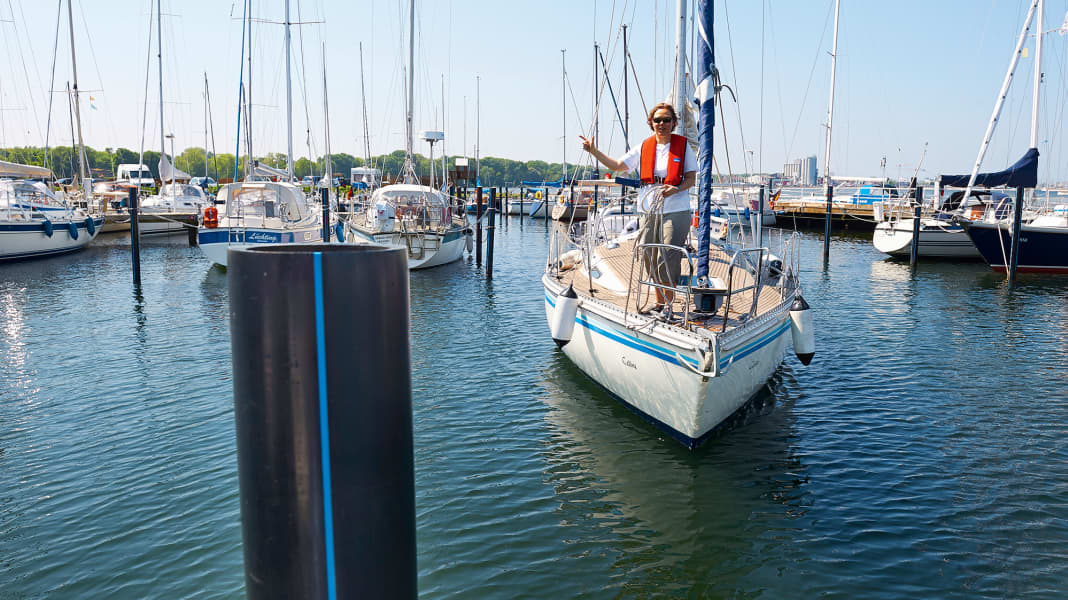
Harbour manoeuvres are one of the most irritating topics for sailors. The spread of bow thrusters and docking systems has not changed this to any great extent. Hardly anything generates as much feedback in the editorial department as when it comes to mooring and unmooring a yacht. Lectures at trade fairs are crowded, the title "Harbour manoeuvres step by step" from Delius Klasing Verlag has been one of the best-selling specialist books for years, and hundreds of sailors use the YACHT webinar on the subject every year to refresh or expand their knowledge.
Why fear port manoeuvres?
Perhaps because the proportion of charterers in the overall sailing population is increasing. Unlike owners, part-time skippers don't know their yacht inside out and face the challenge of getting used to it every time they go on holiday.
Perhaps the unbroken topicality of the subject is also due to the fact that yachts are getting bigger and bigger. A 30-foot boat is now considered an entry-level size in the owner's segment; Hallberg Rassy, for example, has just announced that the HR 310 will be phased out at the end of 2024 and the entry-level boat will be the 340.
Ships over 40 feet are common for chartering. However, the harbours do not grow with the yachts, which means less manoeuvring space and cramped berths.
Modern yachts are susceptible to wind during harbour manoeuvres
The demand for comfort below deck is also increasing. Freeboards and cabin superstructures have to grow to provide space and headroom, as does the width of the boats. All of this results in an ever-increasing area exposed to the wind, with ever flatter frames and narrower keels.
The consequence: although modern yachts sail well and are also very manoeuvrable, they quickly drift away, especially in crosswinds. This increases the importance of accurate harbour manoeuvres because there is less time to correct mistakes - especially as the weight of the yachts increases with their size; in the event of collisions, things can quickly break. Remember: force equals mass times acceleration.
For all these reasons, harbour manoeuvres are a kind of supreme discipline - and are a source of amusement when they fail. Especially at the start of the season, every skipper should at least remind themselves of the basics for stress-free harbour manoeuvres. In these 20 tips, we explain how to make the yacht ready before leaving and entering the harbour, how to make the best use of aids and what you should consider when choosing a berth:
More articles on port manoeuvres
Port manoeuvring tip 1: Involve the crew
The biggest mistake in harbour manoeuvres is time pressure. A few minutes of briefing and information can prevent misunderstandings. Involve the whole crew, explain which manoeuvre is planned and who is to take on which task. If possible, assign everyone a task, such as observing any oncoming vessels or having a ball fender ready. Unoccupied people on board, especially children, tend to be more active and, in the worst case, bring unrest and chaos to the manoeuvre.

Port manoeuvre tip 2: Prepare mooring lines
Before mooring, prepare at least four mooring lines, two forward and two aft. This ensures that the crew is prepared for any situation, even if the original plan is changed at short notice. Pass the mooring lines from on board over the bow or stern pulpit or the railing and then attach them to the respective cleat from the outside inwards under the lower wire. In this way, the mooring line can be thrown or passed over the railing when the boat is moored and is still correctly guided afterwards.
Whether the fixed part is covered with an eye on the cleat and whether an eye is to be knotted into the loose part depends on the conditions on site. If the situation is uncertain, the fixed part can initially be secured with an eight-knot as shown. This allows the mooring line to be quickly tightened from on board. For quick mooring on cleats or bollards ashore, you can also hand over the entire coil so that the mooring line is under tension more quickly than when it is hauled tight on board. However, this requires an experienced helper ashore.
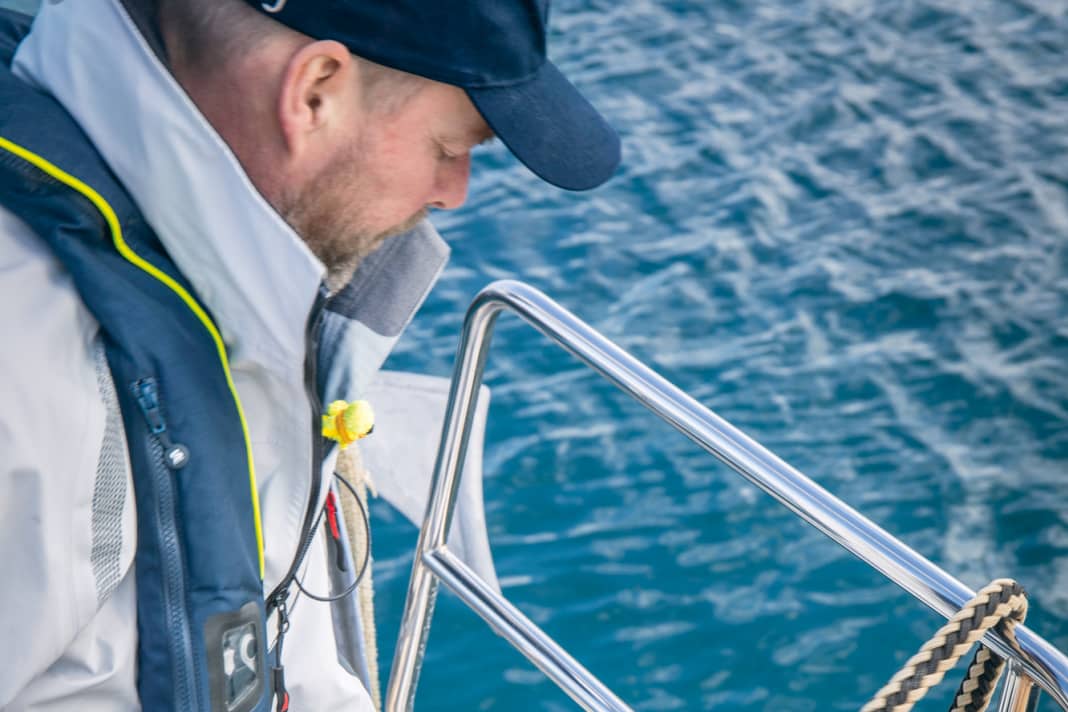


Harbour manoeuvre tip 3: Lay mooring lines correctly
Shoot the mooring lines in large bays, starting from the fixed part and working towards the loose part. In this way, any kinks are turned out. Lay the line bundle loosely on deck so that it cannot accidentally fall into the water and get caught in the propeller. Lay the first bight to the fixed part downwards, the loose part upwards - then you are prepared for all eventualities. If there are mooring rings on the jetty, for example, the loose part on top can be found quickly.
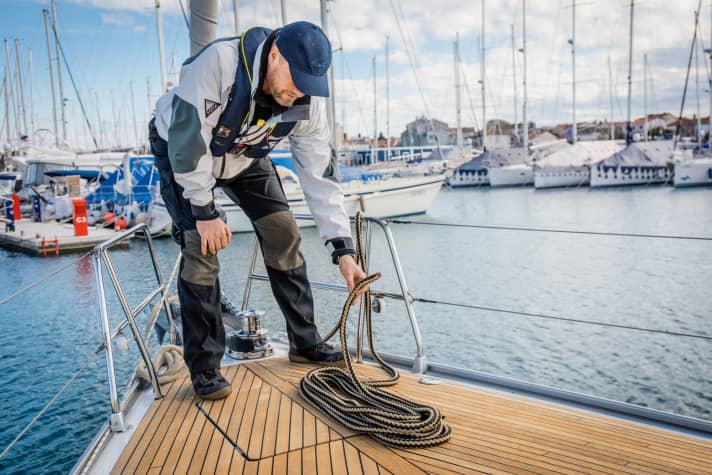
Port manoeuvre tip 4: Protect your hands
Ring lines are often not only disgustingly muddy, but also very coarse and overgrown with mussels. These can quickly cut your hands. But even a clean mooring line can cause nasty burns if it slips through your hands under load. Therefore, wear gloves as a precaution, preferably thick ones that still allow you to get a full grip. Because of the muddy mooring lines, it is advisable not to wear the best clothing, as dirt often splashes when hauling through. Also, always wear shoes!
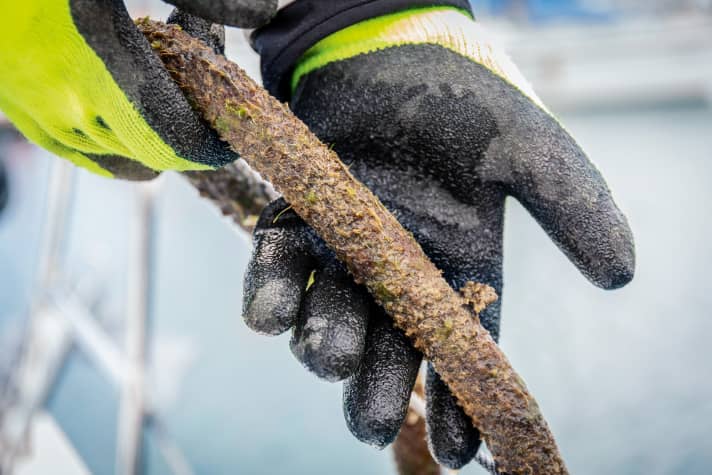
Harbour manoeuvre tip 5: Cast lines correctly
The crew on board should be familiar with the correct throwing technique so that a helper ashore does not have to untangle the entire bundle before he can tie up the mooring line. To do this, start by shooting the line from the fixed part in large bays. Take the bundle loosely in the hand that is not throwing. Then remove two to three bays with the casting hand. Depending on the distance, throw these with all your strength or with a slight swing; do not inadvertently close your hand with the bunch. If there is a lot of momentum, the entire mooring line will run off, otherwise excess line will remain on board until it is hauled tight.
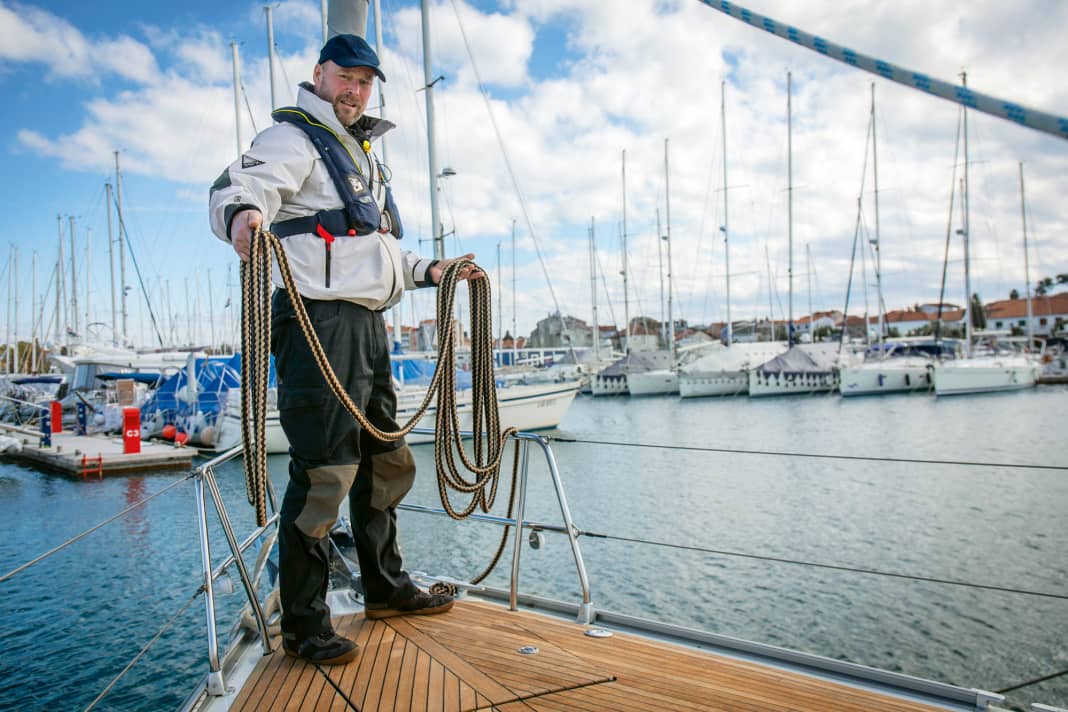



Harbour manoeuvre tip 6: Deploy fenders cleverly
When mooring without piles, as in the Mediterranean, the fenders must be hung before passing between other yachts. However, if there are piles, the fenders should only be deployed after the respective pile has been passed, as they could otherwise get jammed between the hull and the pile, damaging the railing and causing the manoeuvre to slow down abruptly. Therefore, only lay out the fenders on deck and place the fender line under the lower wire and outwards on the upper wire. This prevents them from being accidentally lost when mooring and - more importantly - they can be easily moved outboard with a kick when mooring.



Port manoeuvre tip 7: Use the middle spring
If there is a third pair of cleats on deck, this is often better suited than the aft cleats for mooring between piles, for example. However, so that this mooring line can also be operated by a small crew or single-handedly, it is necessary to lead it aft to the helmsman after pulling it through the cleat feet. The helmsman can then manoeuvre the yacht and operate the mooring line via a winch at the same time, for example after attaching an eye to a pole. It is important that the part lies outboard over deployed fenders, otherwise these can pinch the line.

Port manoeuvre tip 8: Manoeuvre and occupy murings correctly
Muring lines are usually very thick and stiff. They often have to be pulled tight with force. Make sure your posture is correct: Straight back, the legs do the hauling by bending and stretching. Normally, the line is led from the front around the rear horn of the cleat from the outside inwards and pulled tight. If there are lip cleats, i.e. guide eyes that are open at the top, the mooring line should be pulled through these from the start; once it is fully under tension, it can hardly be brought in. If the distance between the luff cleat and the cleat is too small, as can be seen here, the mooring line must first be passed around the front cleat horn, otherwise the friction will be too great. Guide the line completely around the cleat once, then cross it once, then cover it with a half-hitch.
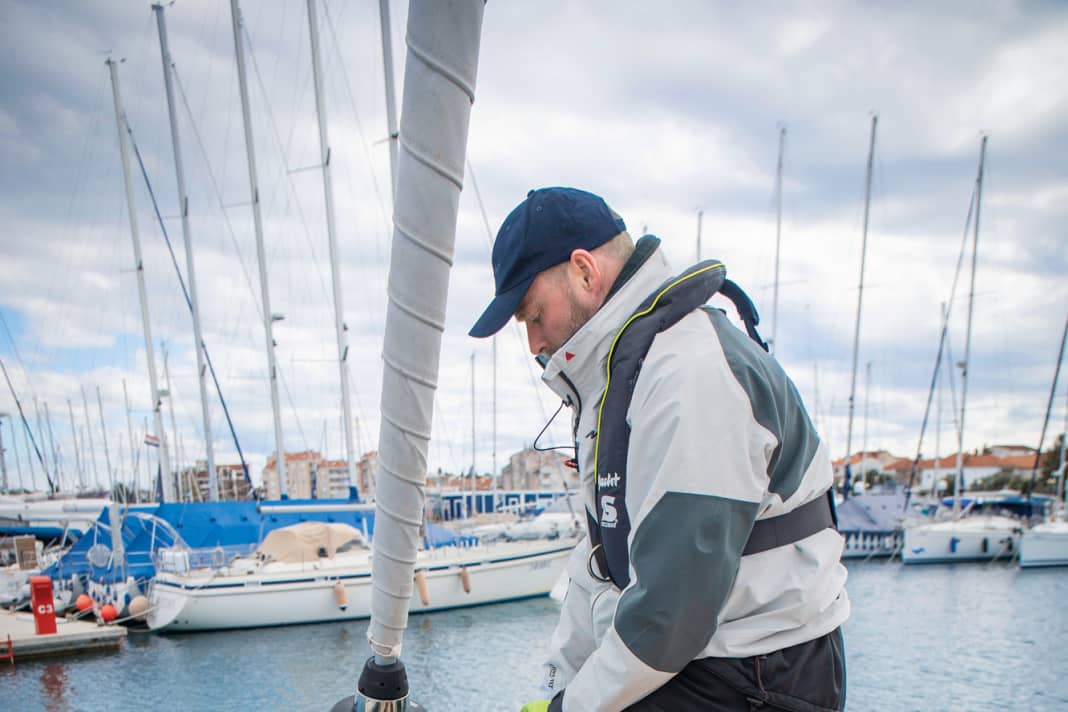


Port manoeuvre tip 9: Communicate visually
Loud commands often lead to stress and discord, and are also a great source of amusement for the spectators in the harbour cinema. The most frequent information that needs to be exchanged between crew members and the person at the helm is the distance to the berth. A simple hand signal has proved its worth here: each finger stands for one metre, the person indicating counts down the metres one by one, a fist means stop.

Harbour manoeuvring tip 10: Utilise the boat's beam
When mooring in a box with stern piles or alongside, the crew should stand close to the shrouds, hand over the lines there and also step over to land at this point. This is because this is where the yacht is widest and the distance to the pile or land is therefore shortest. The crew can also hold on to the shroud to secure themselves, lean out or climb over. This also allows the helmsman to manoeuvre the yacht on a direct course to the berth. Otherwise, the helmsman has to make several course corrections in order to bring a person standing in the bow close enough to the pile or the floating dock and then position the boat properly; this makes the manoeuvre unnecessarily difficult.
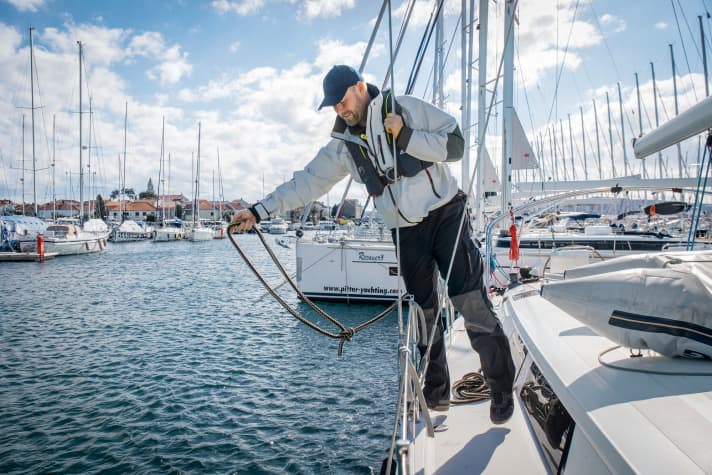
Harbour manoeuvring tip 11: Use the boat hook correctly
To pick up the mooring line and pull the yacht towards a neighbouring berth or jetty, the boat hook must be within easy reach. It should therefore be removed from any brackets before the manoeuvre and made ready. A suitable place for this is behind the handrails on the superstructure, but it can also be placed on the side deck on the foot rail. Cockpit benches, on the other hand, are not a good place. There are often several crew members in the cockpit during manoeuvres. Handling the long pole quickly can end in a lance stabbing.
The boat hook is suitable for pulling the yacht in, not so much for pushing it off. This is because if the tip slips off, the person pushing may end up marching behind and outboard. It is possible to hook behind another person's railing to pull the yacht in. This is designed for outward loads, but holds much less inwards. But no owner likes that. It is therefore better to attach the hook to a cleat and generally only use it on another yacht if nothing else, such as the use of lines, is an option.
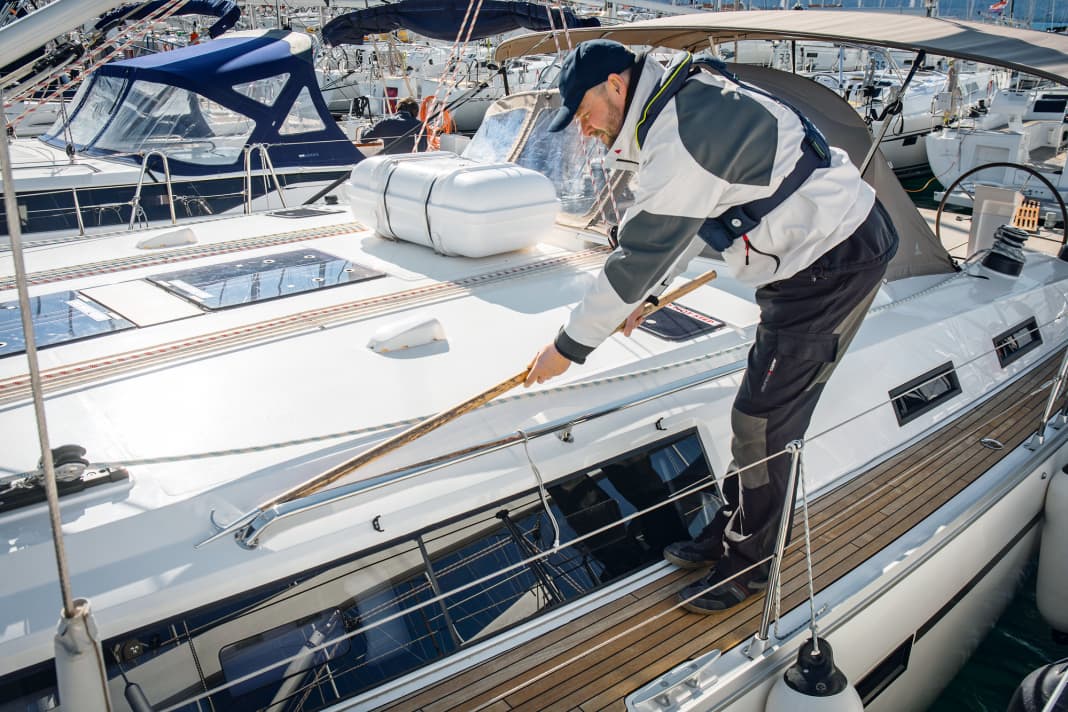




Harbour manoeuvre tip 12: Keep the sails clear
Whether mooring or casting off: The main and genoa should be rigged, free of tarpaulins and prepared for quick setting. Because the engine can fail; a plastic bag in the cooling water inlet, a line in the propeller or dirt in the fuel tank is enough. Then the sails are the only way to manoeuvre the yacht out of a dangerous situation.
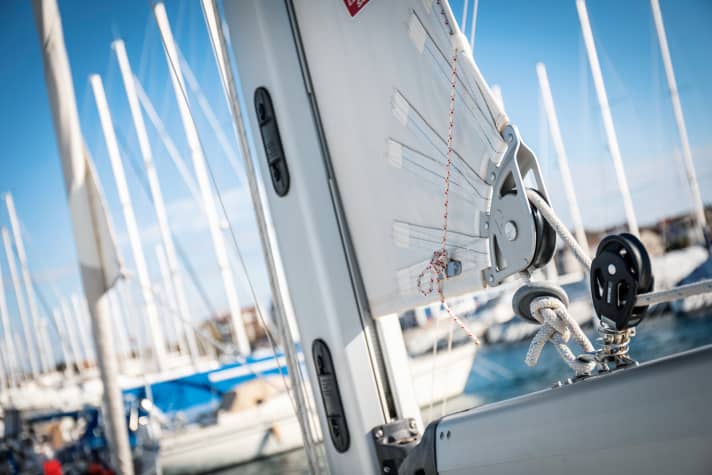
Port manoeuvre tip 13: Use your body less
Material can always be replaced, body parts rather not. It is therefore better to risk a few scratches to the hull and the bail rather than your own health. Moderate holding off or pulling in is fine, however, and the shrouds are very well suited for this; your own shroud serves to secure yourself. However, never place any part of your body between your own yacht and a neighbouring yacht or a jetty. This can lead to crushing or, if you slip, to going overboard.




Port manoeuvre tip 14: Reverse into narrow lanes
If it is not entirely clear whether there is enough space in an alley to turn, it can also be approached backwards if the manoeuvring characteristics of the yacht permit this. If no berth is found in this lane, it can simply be left forwards. If, on the other hand, it is approached forwards, there is a risk that the stern will be displaced due to the wheel effect and the yacht will end up in other mooring lines or be pushed onto a row of piles.

Port manoeuvring tip 15: Anticipate the mooring situation
Preparation for harbour manoeuvres also includes precise knowledge of the local conditions. Information about a foreign harbour includes knowledge of mooring possibilities with sufficient draught and, in the case of piles, places with enough clearance for the width and length of the yacht. The distribution of the jetties, the width of the lanes and the manoeuvring space for turning are also important information. It is therefore essential to study the harbour plan before mooring or unmooring.
A harbour can also fundamentally change its characteristics depending on the wind direction and strength. If the yacht was moored against the wind the day before, it may have shifted overnight and is now pushing the yacht against the berth. The yacht's turning circle can also change depending on which side the wind is coming from. A foil placed over the harbour plan can be an aid, especially when entering a foreign marina. First draw in the wind direction, then mark the zones where leeward winds may occur, then mark the shallows and narrows. It also makes sense to call the harbour master by mobile phone or radio. The harbour master will often have a mooring tip or help you moor or cast off with a dinghy.




Harbour manoeuvre tip 16: Focus on the windward lines
Trying to tie up all four mooring lines with a small crew when entering the box despite the crosswind is risky - the danger of drifting sideways into your neighbours if you miss the windward poles is too great. Therefore, concentrate on the two windward lines so that the yacht is initially stable despite the crosswind. You can deploy the leeward lines later at your leisure, for example with the dinghy. The "windward line principle" also applies when mooring astern with an anchor or mooring ring and two stern lines.
Where is Luv? It sounds banal, but it cannot be repeated often enough: The clicker in the mast is the best indicator of the wind direction. The order in which the mooring lines are untied or tied up depends on it. The following applies when mooring: First tie up to windward, then to leeward. When casting off: First untie to leeward, then to windward. One glance upwards is enough: Take out the lines where the tip points.
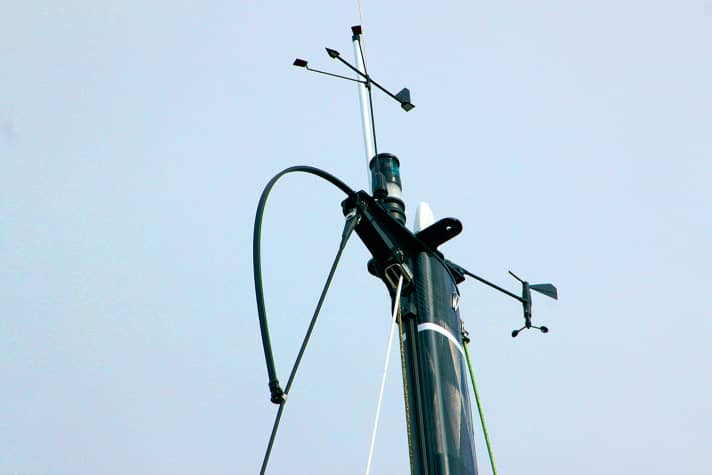
Port manoeuvre tip 17: Mooring provisionally
Nobody needs a hectic pace on board, especially in a tricky situation. If there is a strong breeze and it is not immediately possible to find a place in the harbour basin, the helmsman in particular is faced with many demands: to manoeuvre the yacht safely and at the same time keep an overview of the harbour, the conditions and the crew's tasks. To avoid a dangerous rush, the crew is well advised to take a break, i.e. to moor temporarily: simply look for a pole or other anchorage point to windward and moor to it with a fore or aft line.
The yacht is pushed to leeward by the wind and hangs securely on its line. Now the crew can clear up in peace, let heated tempers cool down, get an overview and, if necessary, seek help by radio from the harbour master or from nearby skippers.
Port manoeuvre tip 18: Check the engine
Start the engine in good time before casting off, when mooring before reaching the harbour, warm up, test forward and reverse thrust. Ensure good fuel quality (diesel pest), check filter. If there is a risk that suspended matter in the tank could clog the filter due to rocking in rough seas, which could lead to engine failure: consider whether it would be possible to start the engine under sail. Use the outboard motor in combination with sails when the waves are steep, as the submerging propeller provides insufficient thrust and the boat is quickly displaced. Refuel in good time!
Harbour manoeuvre tip 19: Clear the deck
If possible, remove wind deflectors such as the cake stand, sprayhood, bimini and railing cover in strong winds. This reduces the area exposed to the wind and thus minimises the risk of drifting when sailing at low speed. Close hatches and forecastle boxes, otherwise there is a risk of injury. In addition, sheets or mooring lines can get caught on the open lids and damage them. Securely lash down all objects on deck, such as the dinghy. Also make sure that loosely attached life-saving equipment such as a rescue collar or ring cannot be pulled out of their mountings by lines.
Harbour manoeuvre tip 20: Anchor clear to drop
The anchor should be clear for an emergency manoeuvre, so pull any safety bolts and be sure to switch on the windlass safety catch and briefly check its function. If the yacht is drifting with engine failure and a leeward wall situation is imminent from which you cannot sail free, the anchor is the last hope before stranding.

